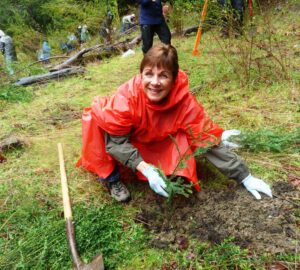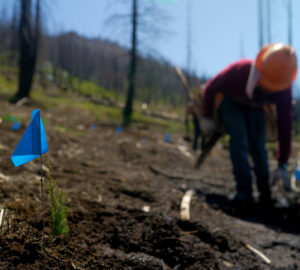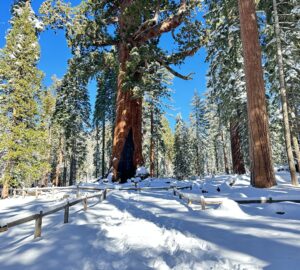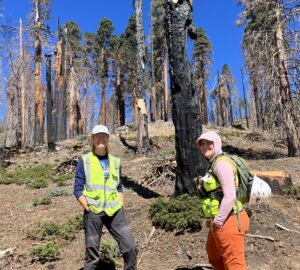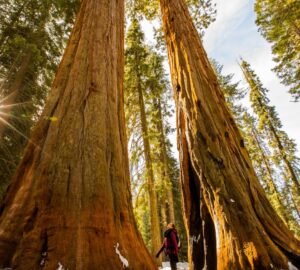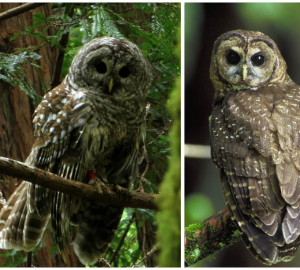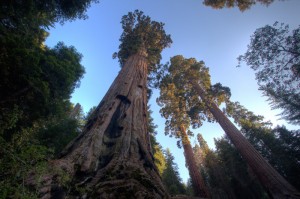
RCCI’s nursery experiments and tree ring analyses are essential to understanding the past and future of the redwood forest, but it is the trees themselves that tell us about its present. By establishing 16 large plots in old-growth forests throughout the range of coast redwood and giant sequoia, by climbing the giant trees, measuring them along their height and limbs, and by mapping their locations relative to one another, researchers were able to measure, map and understand these ancient stands as never before. Through this research, we are now able to tell just how big these trees and forests really are… And the results have surprised everyone.
Let’s begin with the trees themselves. The largest coast redwood in the plots had a staggering 1.12 BILLION leaves (needles), which, when laid out, would cover nearly 2.4 acres, the size of two football fields! The largest giant sequoia had even more leaves – 1.94 billion – but because they are smaller, they only cover around a mere 1.7 acres. These needles do the yeoman’s work of turning sunlight, air, and water into wood, and they do it well.
Giant sequoias, the largest trees on Earth, were found to be as large as 550 metric tons of dry mass, with coast redwoods not far behind at 424 tons. The dry mass figure is a measure of how much the wood would weigh if all the water were removed (so, the standing tree weighs much more). Volume is a hard thing to picture, so imagine the average household stove – that’s around one cubic meter. Now, picture a coast redwood as big as 1,100 of those stoves. If that weren’t challenge enough, next try to imagine a giant sequoia as large as 1,500 stoves! Sometimes in the course of investigation, we find interesting things that we weren’t even looking for. For example, the RCCI team also found the oldest known coast redwood, clocking in at a spry 2,520 years (the previous record was around 2,200)!
The trees are not only really big, but they’re growing, and growing fast. By combining measurements of the tree’s current size with tree ring data, the team discovered that tree growth increased with size, which means that the larger the tree is, the faster it grows. This increase in growth is more than just a geometric effect of adding wood to a larger and larger circle (the team tested this and found that big trees’ growth increased more than could be explained by this phenomenon), and is likely caused simply by the fact that larger trees have more leaves, and thus can perform more photosynthesis.
As you might imagine, when you get a whole bunch of these great big trees all growing together, that forest will also be incredibly productive. We have known for a while that redwood forests have more biomass (living plant material) than just about anyplace else, but the RCCI research has allowed us to understand how much bigger they actually are.
The northern coast redwood forests are world champions, containing over twice as much biomass as any non-redwood forest. It’s hard to imagine the numbers relative to everyday life, so here it is straight: one RCCI plot contained 5,000 tons of biomass per hectare. Of this, as much as 25% (over 1,000 tons) was made up of dead wood. Redwood’s rot resistance means that this dead wood will remain in the forest for centuries, contributing to the forest’s incredible ability to capture and store atmospheric carbon.
Superlatives are great, but why does it matter how big these trees are or how fast they grow? What are the implications for conservation?
First of all, over the course of figuring out all the staggering numbers, the team built equations for measuring many of the common forest species that will enable resource managers and conservationists to understand the size of their own forests using just a few simple, common measurements.
There are also great potential implications for forest conservation and management to be seen in these results. Since the ancient forests are larger and growing faster than we previously believed, and since these forests are composed in large part of carbon that is sucked out of the atmosphere through photosynthesis, we can now see that the ancient redwood forest has an incredibly important role in combating climate change. This in turn will hopefully influence forest managers to keep more trees standing longer. Large trees grow faster, and faster growth means more carbon removed from the atmosphere. If the price for carbon continues to increase (as it almost certainly will over the long term), knowing how quickly trees assimilate that carbon will help to put a price on their value as living organisms rather than products.
Will this change the amount of industrial forestland set aside in reserves? Will it influence the ways that foresters choose trees to be harvested? Will it provide incentives for landowners not to sell or develop their land? The possibilities are many and varied, and as we continue to build and expand RCCI, the questions that will lead to concrete conservation outcomes will be front and center in our planning.


